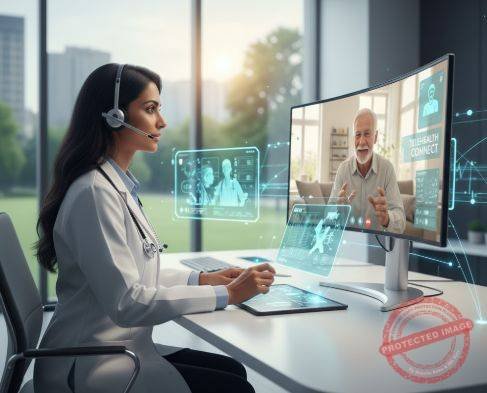From Virtual Visits to AI-Powered Care—How Technology Is Making Healthcare More Accessible, Affordable, and Efficient Than Ever Before.
The Telehealth Transformation
The healthcare industry is experiencing one of its most profound revolutions in modern history. What began as a response to necessity during the COVID-19 pandemic has evolved into a global digital care movement.
Telehealth—once considered a temporary convenience—has become a permanent pillar of modern medicine. Patients can now consult doctors from their homes, specialists collaborate across borders, and hospitals extend care far beyond physical walls.
In 2025, telehealth represents not just a service model, but a healthcare ecosystem—one powered by connectivity, data, and patient empowerment.
Expanding Access Through Technology
The most transformative power of telehealth lies in its ability to democratize access to care.
-
Rural and Underserved Regions: Patients in remote areas can consult with top-tier specialists through secure video platforms.
-
Chronic Disease Management: Continuous digital check-ins reduce hospital visits and improve adherence to treatment plans.
-
Global Expertise: Physicians can collaborate across continents, sharing data and diagnostic insights in real time.
-
Emergency Response: Remote triage systems allow faster decision-making in critical care situations.
By removing geographic and logistical barriers, telehealth is fulfilling the promise of healthcare without boundaries.
From Virtual Visits to Continuous Care
Telehealth is no longer limited to one-off video consultations. The integration of electronic health records (EHRs), remote monitoring devices, and AI-driven analytics has transformed it into a model of continuous, connected care.
Today’s telehealth systems integrate real-time patient data from wearables, IoT sensors, and home diagnostics—creating a dynamic feedback loop between patients and providers.
This shift supports proactive healthcare, where early detection and intervention prevent complications before they require hospitalization.
AI and Automation in Telemedicine
Artificial Intelligence (AI) plays a central role in enhancing telehealth efficiency and accuracy.
-
Virtual Assistants: Automate appointment scheduling, triage, and patient education.
-
Predictive Analytics: Identify patients at risk of chronic disease escalation.
-
Computer Vision: Supports remote dermatology, radiology, and pathology diagnostics.
-
Natural Language Processing (NLP): Transcribes and summarizes patient visits for EHR integration.
AI not only empowers clinicians to make faster, data-backed decisions—it also personalizes the care journey for every patient, improving outcomes at scale.
The Economics of Telehealth
Telehealth is also redefining the economics of healthcare.
-
Cost Reduction: Virtual consultations reduce overhead and emergency room strain.
-
Workforce Optimization: Clinicians can serve more patients efficiently through hybrid scheduling.
-
Insurance Integration: Major insurers now reimburse telehealth at parity with in-person visits.
-
Employer Healthcare Models: Corporations are adopting telemedicine as part of employee wellness programs.
According to McKinsey, telehealth could represent up to $250 billion of annual U.S. healthcare spending in the coming years—driven by its convenience, scalability, and proven outcomes.
Challenges on the Path Forward
Despite its promise, telehealth faces key challenges:
-
Digital Divide: Unequal access to broadband and smart devices limits inclusivity.
-
Licensing and Regulation: Cross-border care requires harmonized laws and standards.
-
Cybersecurity Risks: Increased data exchange raises the threat of privacy breaches.
-
Human Connection: Maintaining empathy and patient trust in virtual settings remains crucial.
Addressing these barriers requires collaboration between policymakers, providers, and technologists to ensure equitable, secure, and compassionate care.
Global Perspectives and Innovation
Across the world, telehealth innovation is accelerating:
-
India is deploying national telemedicine networks to reach rural populations.
-
Europe is standardizing digital health records through the EU Health Data Space.
-
Africa is leveraging mobile-first telemedicine to overcome infrastructure gaps.
-
North America continues to integrate telehealth with advanced AI diagnostics and cloud-based EHRs.
This global movement signals a new era of digital public health infrastructure, built on data, interoperability, and accessibility.
Closing Thoughts and Looking Forward
Telehealth is more than a technological innovation—it’s a human innovation. By breaking down barriers of distance, time, and access, it’s creating a healthcare model that is patient-centric, data-driven, and globally connected.
The next phase of telehealth will integrate AI, wearables, and remote diagnostics into a seamless experience that follows patients across their entire healthcare journey.
The digital doctor is not just in—it’s everywhere, empowering a healthier, smarter, and more equitable world.
References
-
“Telehealth: A Quarter-Trillion-Dollar Post-COVID Reality” – McKinsey & Company
https://www.mckinsey.com/industries/healthcare-systems-and-services/our-insights/telehealth-a-quarter-trillion-dollar-post-covid-reality -
“The Global Impact of Telemedicine on Healthcare Access” – World Health Organization (WHO)
https://www.who.int/publications/telemedicine-global-impact-on-healthcare -
“AI and Automation in Digital Healthcare” – Deloitte Insights
https://www.deloitte.com/insights/ai-and-automation-in-digital-healthcare -
“How Telehealth Is Reshaping Healthcare Delivery” – Harvard Business Review
https://hbr.org/2024/07/how-telehealth-is-reshaping-healthcare-delivery -
“Remote Care Models: Building the Future of Digital Health” – Forbes Tech Council
https://www.forbes.com/sites/forbestechcouncil/2024/09/14/remote-care-models-building-the-future-of-digital-health
Author: Serge Boudreaux – AI Hardware Technologies, Montreal, Quebec
Co-Editor: Peter Jonathan Wilcheck – Miami, Florida
Post Disclaimer
The information provided in our posts or blogs are for educational and informative purposes only. We do not guarantee the accuracy, completeness or suitability of the information. We do not provide financial or investment advice. Readers should always seek professional advice before making any financial or investment decisions based on the information provided in our content. We will not be held responsible for any losses, damages or consequences that may arise from relying on the information provided in our content.



